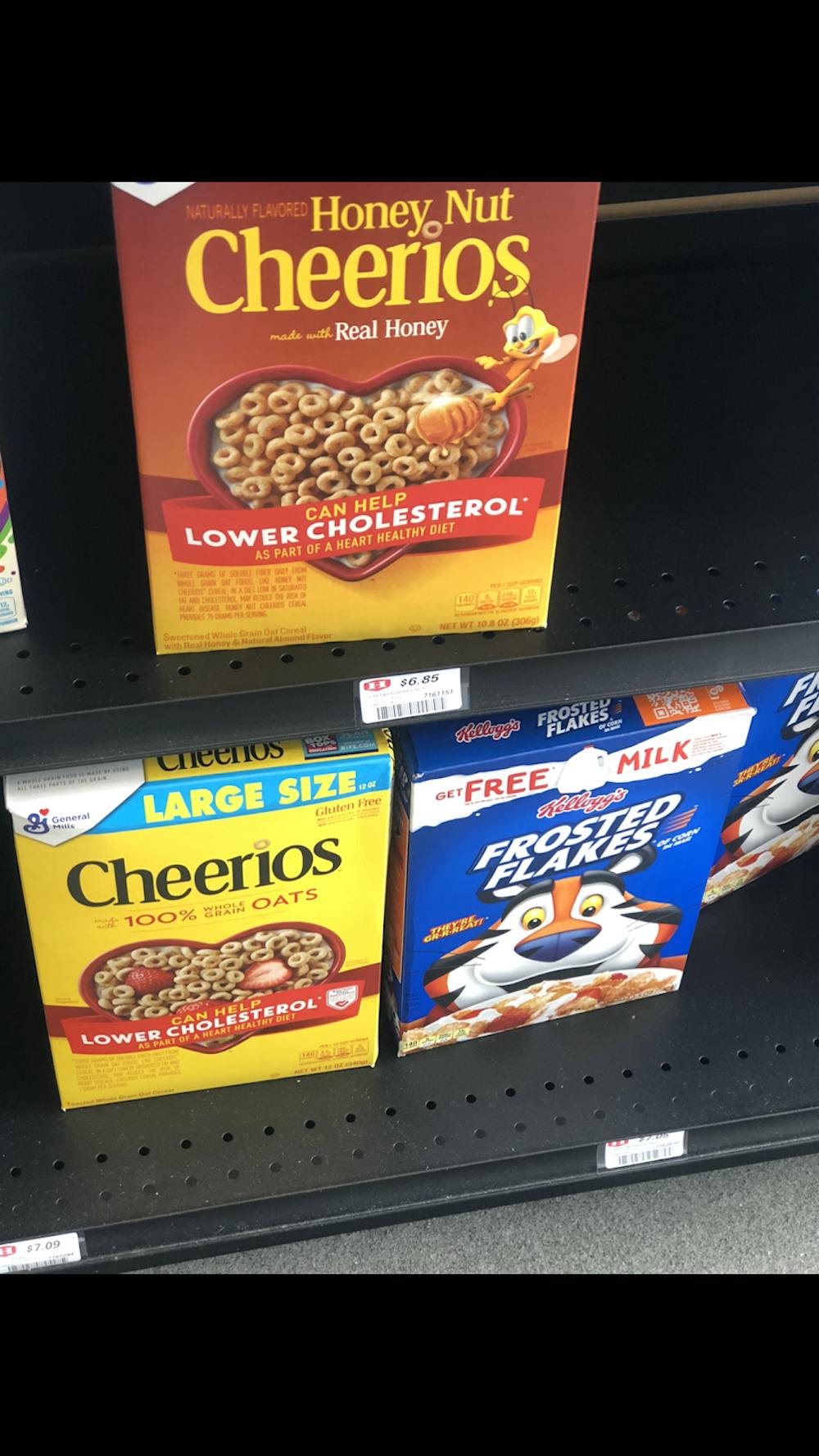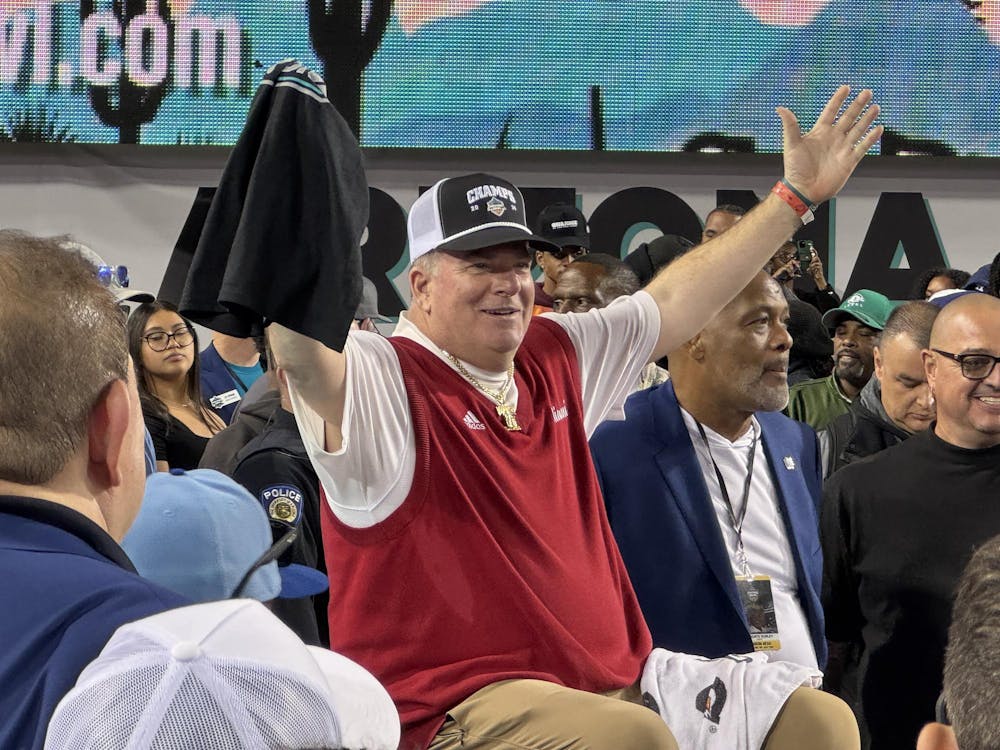With a Miami University ID card, students can buy grocery items at market locations across campus. But many students have noticed high prices at the markets and wonder if the goods are really worth the cost.
Miami has 11 markets on campus, one of which is Scoreboard, located inside North Quad’s Martin Dining Hall. At Scoreboard, an array of snacks, bread and candy are on display.
Walking through each section, a certain breakfast staple stops the student walking by. The top shelf reads $6.85 for Honey Nut Cheerios, and the bottom shelf displays Frosted Flakes for $7.05.
At the Oxford Kroger, both Honey Nut Cheerios and Frosted Flakes are priced at $2.99 as of April 23.
First-year English education major Trinity Lewis recalled her experiences at the markets last semester.
“I used to go to the market all the time,” Lewis said. “I would end up spending like $50-$70 each time I went because of how expensive things were.”
First-year bioengineering major Jonathan Serrano also raised concerns about the markets’ prices.
“The prices are absolutely ridiculous all around,” Serrano said. “Milk itself costs $3 for not even a gallon. Sure, our meal plans have $100 or more, but that money isn’t a gift from Miami, it just comes from our payment for our meal plan.”
While market prices give students pause, they also struggle to find transportation to other grocery options off campus.
Miami doesn’t permit first-year students to park on campus, except for the case of “express university authorization.”
First-year history major Lauryn Zilles shared her experience on the busing system.
“I think the busing system is a little unorganized, and I don't think they do a very good job telling students the different schedules,” Zilles said. “There's been times I've been on the bus and the route was completely different, and I ended up like being on it for hours; I didn’t know where I was going.”
Enjoy what you're reading?
Signup for our newsletter
From the location of Scoreboard Market, Kroger, the nearest chain grocery store, is 10 minutes away by car and 37 minutes by walking.
Butler County Regional Transit Authority buses have routes that travel to Kroger, but those buses are not always effective for students.
“Not a lot of people know the schedule, they don't know if it's going to Kroger or if it's going somewhere else,” Zilles said. “I think a lot of people are hesitant to take the bus or to go to Kroger to get what they need because of that reason.”
According to Global Trade Magazine, stores gain their supply “through wholesale or bulk distributors.” Kroger, for example, stocks 13,000 private label items from various suppliers.
Bryan Gutridge, senior director of event services and overseer of market operations, said Miami does not have the ability to purchase items in bulk for its markets.
“We do not have the purchasing power of larger grocery chains since we do not buy in massive volumes, and so there is a greater cost to the university than larger stores,” Gutridge said.
Gutridge said that Miami chooses which items to stock based on consumer trends.
“We work with vendors to see what items are doing well in similar areas and college campuses,” he said. “We take into consideration requests from our customers.”
But Miami is not alone in it’s high market prices.
In an article published by the University of Arizona’s Daily Wildcat, there was found to be a 68.71% increase in prices at the school’s markets in comparison to one local grocery store.
In a Forbes article, Professor Emeritus of economics at Ohio University Richard Vedder, said students are negatively affected by these price increases. He recalled his findings about general university market prices.
Vedder and his colleagues looked at commonly purchased items like candy, soap and cereal.
“The basic conclusion was that the prices were dramatically higher, sometimes twice as much in the monopoly facilities near campus that the university controls,” Vedder said.
Vedder said universities operate through a monopoly-like power structure.
“There’s no question that universities are taking advantage of their market position,” Vedder said. “In having near-monopoly powers over the students, it’s difficult for the students to get to locations where there is competitive pricing of goods. So the universities take advantage of this by raising their prices.”
Alluding to his Forbes article, Vedder posed the question once again, if it’s appropriate for universities to “rip-off” students by charging unofficially high prices.
Charles Moul, associate professor of economics, said the future of Miami’s market prices is still uncertain.
“Predicting how a retailer will change its markups over time is as difficult as any other forecast,” Moul said. “If students find the markups excessive for the level of convenience provided, they can provide a public service and incur travel costs and hassle to patronize off-campus groceries.”
Moul also said that if students were to frequent off-campus grocers, this could show a greater student demand for specific groceries. He predicted the future cost of student groceries would potentially decrease.
“This will then show up in Miami's sales and convey that student demand is more price-sensitive than Miami had thought,” Moul said. “The end result would be Miami accepting a lower markup by lowering prices to all customers.”
Vedder doesn’t see it happening soon.
“As for ‘one can hope,’ I don’t anticipate it happening,” Vedder said “Colleges right now are facing financial pressures that are greater than usual, given the COVID-19 situation.”




